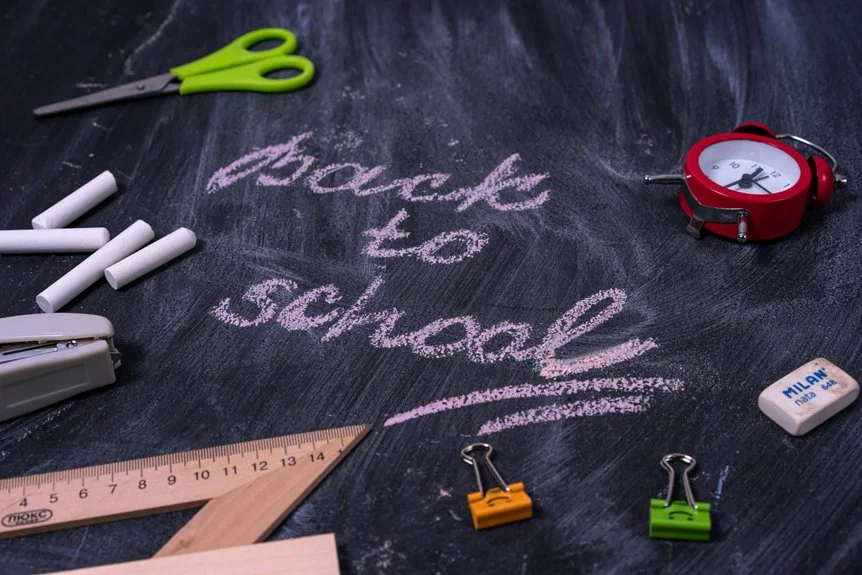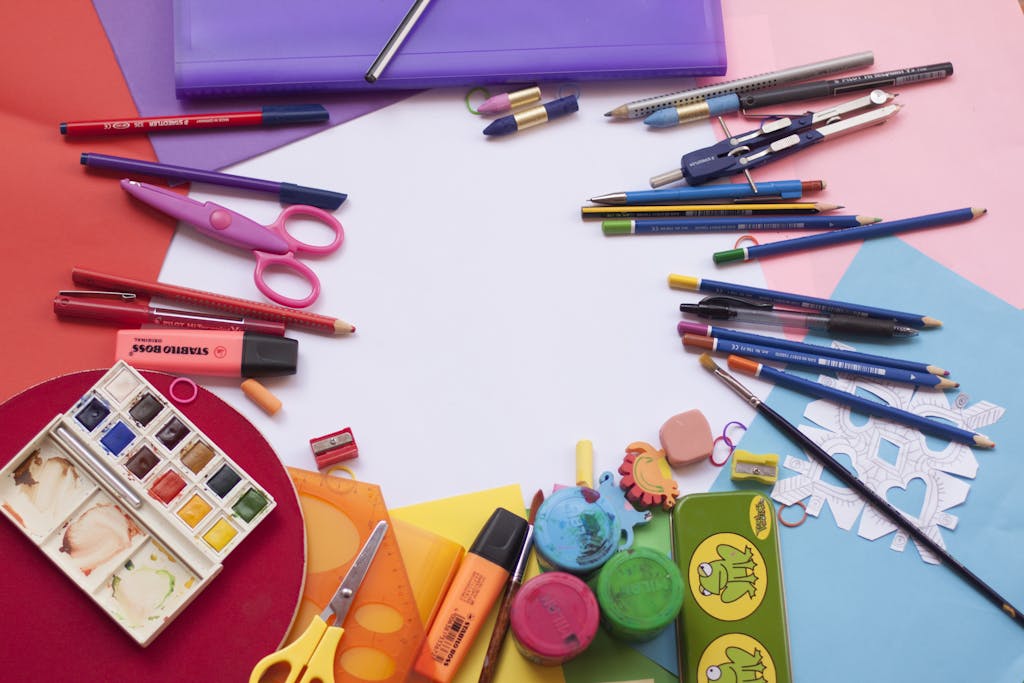
You’re staring at that back-to-school supply list, aren’t you? The one that somehow costs more than your monthly grocery budget. Last year, I dropped $347 on school supplies for daughter, and half of it was stuff we already had buried in our junk drawer. But here’s the thing – I’ve cracked the code on slashing those costs by 60% without making your kids feel like they’re shopping at a thrift store from 1987. Ready to become a back-to-school budget ninja?
Key Takeaways
- Start a dedicated sinking fund early in the year, automatically transferring money after each paycheck to spread costs over time.
- Take inventory of existing supplies at home before shopping to avoid duplicate purchases and discover forgotten items.
- Shop secondhand through thrift stores, Facebook Marketplace, and community giveaways to save 60-80% on uniforms and supplies.
- Begin shopping in July for early season discounts and monitor weekly sales cycles to avoid expensive last-minute purchases.
- Focus on absolute necessities first and delay trendy, non-essential items until they’re discounted later in the school year.
Take Inventory of What You Already Have
Before you even think about stepping foot in a store, grab a coffee and spend thirty minutes hunting through your house like you’re on a treasure hunt. You’ll be amazed at what you discover hiding in junk drawers, backpack pockets, and that mysterious desk corner. I found $47 worth of perfectly good supplies last year, including 23 pencils, three unopened glue sticks, and enough erasers to last until graduation.
Start with your kids’ backpacks from last year. Check every zipper pocket and compartment. Then raid your home office, kitchen drawers, and anywhere you’ve stashed random supplies. Make a detailed list of everything you find. This simple inventory will save money and prevent you from buying duplicate items you don’t actually need. Use a consistent naming system to organize your supply list by category, making it easier to reference when you’re actually shopping.
Set a Realistic Shopping Budget
Now you’ll need to crunch some numbers and figure out exactly how much this back-to-school adventure is going to cost you. Start by adding up all your expected expenses—supplies, clothes, shoes, backpacks, lunch boxes—and then tack on an extra 15-20% because trust me, you’ll always find something you forgot.
Once you’ve got that total, compare it to what you can actually afford to spend, and if there’s a gap, it’s time to either find more money or start making some tough choices about what’s truly necessary. If you’re looking to generate additional income to help cover these expenses, consider starting a simple business like freelance writing or virtual assistance, which can be launched for under $200 and provide supplemental earnings.
Calculate Total Expected Costs
Once you’ve gathered all those school supply lists and mentally prepared yourself for the financial hit, it’s time to crunch the numbers and figure out exactly what this back-to-school season will cost you.
Break down your expenses into categories to get the full picture:
| Category | Estimated Cost |
|---|---|
| School supplies | $75-150 |
| Clothing & shoes | $200-400 |
| Extracurricular fees | $50-200 |
| Electronics/backpack | $100-300 |
Add everything up, then tack on that essential 10-15% cushion because something always pops up. If your total hits $500, you’ll want $575 in your savings account. Divide this by your remaining paychecks before school starts to determine your weekly savings goal.
Build in Budget Buffer
Smart parents know that sticking to an exact budget is about as realistic as getting kids to put their backpacks in the same spot every day. You’ll save yourself stress by building a realistic buffer into your back-to-school budget. This cushion will help you save money in the long run by preventing those panicked, last-minute purchases at full price.
Here’s how to create your financial safety net:
- Add 10-20% to your calculated total for unexpected expenses
- Include $50-$100 for price fluctuations and emergencies
- Factor in non-school costs like extracurricular fees and clothing
- Review last year’s actual spending, not just what you planned
- Account for those “forgot the calculator” moments that always happen
This buffer transforms shopping from a stressful sprint into a manageable marathon.
Start a Sinking Fund Early

You’ll want to start your back-to-school sinking fund as early as January, because trust me, August sneaks up faster than a toddler with a permanent marker. Calculate how much you spent last year (mine was a painful $400 per kid), then divide that by the number of months or paychecks until school starts to find your monthly savings target.
Set up an automatic transfer of that amount into a separate savings account, so you won’t accidentally spend your school fund on that irresistible Target clearance display. Consider conducting an honest self-reflection on your previous year’s spending patterns to identify where you might have overspent or missed opportunities to save on school supplies.
Calculate Monthly Savings Amount
After crunching my back-to-school numbers last year and nearly choking on my coffee when I saw the $847 total, I learned that breaking down these expenses into bite-sized monthly chunks makes everything way less scary.
Here’s how you’ll calculate your monthly sinking fund amount:
- Estimate your total back-to-school costs (clothes, supplies, fees, shoes)
- Count how many paychecks you’ll receive before shopping for school supplies begins
- Divide your total estimate by the number of paychecks
- Add any existing savings to your sinking fund to reduce monthly contributions
- Set up automatic transfers to make saving effortless
For my $847 estimate spread across 10 months, I needed $85 per month. Starting with $200 already saved dropped my monthly contribution to just $65. Your sinking fund transforms overwhelming expenses into manageable monthly payments.
Automate Fund Transfers
Once I figured out my monthly savings target, I immediately set up automatic transfers because my brain has the memory of a goldfish when it comes to moving money around. I scheduled $150 to move from my checking to my back-to-school fund every payday, right after my direct deposit hits. This way, I never had the chance to “forget” or convince myself I needed that money for coffee runs.
The key is treating this like any other bill you can’t skip. Set the transfer for the same day you get paid, before you start your regular shopping or spending. I use my bank’s app to automate everything – it takes two minutes to set up and runs on autopilot. No willpower required, no mental energy wasted, just consistent progress toward your goal.
Shop Smart With Strategic Timing

When should smart parents start hunting for those back-to-school bargains that’ll keep their budgets intact? Think ahead by starting your shopping spree in July, not August when everyone else panics. Taking advantage of early season discounts beats scrambling at the last minute.
I learned this lesson when I saved $200 by shopping in mid-July versus late August. The same backpack cost $45 in July, then jumped to $65 three weeks later.
Here’s your strategic timing playbook:
- Start shopping July through September for maximum savings opportunities
- Avoid last-minute rushes that force expensive impulse purchases
- Monitor weekly sales cycles at your favorite stores
- Stay flexible as prices fluctuate throughout the season
- Track price patterns from previous years for predictable deals
Strategic timing transforms your budget from stressed to blessed. Consider starting a dropshipping business focused on back-to-school supplies as a way to turn your bargain-hunting skills into a profitable side hustle.
Explore Secondhand and Free Options
Your wallet doesn’t care if that calculator came from Target or your neighbor’s junk drawer, so why should you? Smart parents know secondhand shopping isn’t about being cheap—it’s about being strategic.
| Source | Best Items | Average Savings |
|---|---|---|
| Hand-me-downs | Clothes, backpacks | 100% (free!) |
| Facebook Marketplace | Electronics, supplies | 50-70% |
| Thrift stores | Uniforms, shoes | 60-80% |
| Craigslist | Furniture, bulk supplies | 40-60% |
| Community giveaways | Basic supplies | 100% (free!) |
Your mom would probably lecture about “buying quality,” but here’s the truth: kids outgrow everything anyway. Browse Facebook Marketplace first for nearby deals, then hit thrift stores for hidden gems. Don’t forget community assistance programs—they’re lifesavers when budgets get tight. Consider turning your secondhand shopping skills into a profitable reselling business by flipping quality items you find at great prices.
Use Money-Saving Challenges
Since most of us can’t magically conjure money from thin air, it’s time to get creative with some money-saving challenges that actually work. Make sure you’re maximizing every dollar during back-to-school season with these simple yet powerful strategies:
- Save every $5 bill you receive as change – you’ll be shocked how quickly these add up
- Try a 30-day no-spend challenge on discretionary purchases like coffee runs and impulse buys
- Round up debit card purchases to the nearest $5 and stash the difference
- Start a sinking fund by dividing your estimated expenses by remaining paychecks before school starts
- Use savings challenges like the 10-Day Challenge to accelerate your progress
These aren’t get-rich-quick schemes, but they’ll give you real control over your money. Remember to automate savings by setting up transfers from your checking account to make these challenges effortless and sustainable.
Delay Non-Essential Purchases
While that adorable dinosaur backpack might be calling your child’s name from Target’s endcap display, mastering the art of delayed gratification can save you serious cash during back-to-school season. You’ve got power here – use it strategically.
Start with absolute necessities first. Children in elementary school can usually squeeze another month out of last year’s clothes if weather permits. High school students might actually prefer shopping later when peer pressure reveals what’s truly “cool” this year.
Those fun supplies? They’re marketing traps designed to drain your wallet. Focus on pencils and notebooks first, then circle back for that sparkly pencil case in October when it’s 70% off. Your kids will survive without the latest TikTok-famous lunchbox, and you’ll thank yourself later.
Plan Ahead for Next Year’s Expenses

Once September’s chaos settles and you’re finally catching your breath, that’s actually the perfect time to start plotting your next year’s back-to-school strategy. Smart parents know that every year brings the same supply madness, so why not beat the system?
Here’s your game plan for next year’s domination:
- Research your school’s supply lists in May to identify big-ticket items
- Set up price alerts on Amazon and Walmart for calculators, backpacks, and electronics
- Stock up during post-holiday clearances when notebooks hit 25 cents each
- Build relationships with store customer service teams who’ll notify you about upcoming sales
- Create a dedicated storage bin for gradually collected supplies throughout the year
This approach transforms you from frantic last-minute shopper into strategic supply ninja, saving hundreds while everyone else panics. Consider creating a 12-week plan to break down your back-to-school preparation into manageable chunks, helping you focus on what’s important and stay organized throughout the year.
Conclusion
You’ve got all the tools to transform from that frantic parent grabbing overpriced folders at 9 PM to a back-to-school budgeting champion. Start your sinking fund today, even if it’s just $10 weekly. Take inventory this weekend, and you’ll discover you already own half the supplies you need. With these strategies, you’ll save hundreds while teaching your kids valuable money lessons. Future you will thank present you!





Pingback: 9 Kind Acts That Make You Feel Amazing Too